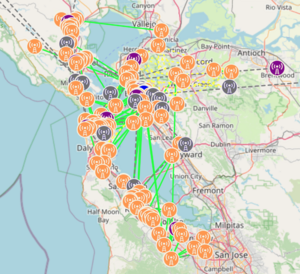Bay Area Mesh: Difference between revisions
Jump to navigation
Jump to search
m (→Communications) |
|||
| Line 57: | Line 57: | ||
==Communications== |
==Communications== |
||
| − | *[https:// |
+ | *[https://aredncommunity.slack.com/ Slack] |
*[https://groups.io/g/sfwem sfwem@groups.io] |
*[https://groups.io/g/sfwem sfwem@groups.io] |
||
*[[Monthly Updates]] |
*[[Monthly Updates]] |
||
Revision as of 18:22, 27 February 2023
Goals
- Education, Research & Mentorship of the Amateur Radio Community on digital network technologies.
- Rapid ad-hoc communication deployments during disasters and emergencies.
- Reliable, fault-tolerant networks that served agencies can protect Bay Area residents and save lives during disaster situations
Getting Started
- AREDN Beginners Guide
- Code of Conduct
- Maps - Various maps of mesh nodes and the connections between them
- Tools - Helpful information and tools
- Videos - Helpful videos
Help
- Antennas - Recommended antennas (for when the radio doesn't come with one)
- Band Plan - How the spectrum is allocated in various areas of the Bay
- Bandwidth Consumption - Bandwidth consumption of various classes of applications
- Batteries - Recommended batteries for off-grid and battery backed-up nodes
- Cables - Recommendation for cabling to use, especially outside
- Cameras - Recommended cameras
- Commercial WISPs - Local commercial WISPs which often share locations
- High sites - Elevated sites which are easy to point a radio at
- Maps - Various maps of mesh nodes and the connections between them
- Network Time Protocol - Using and provide network time on the mesh
- Phones & PBX
- Power-over-Ethernet - Options for providing power to nodes via ethernet
- Radios
- Solar - Solar powered nodes
Projects
- Bay Area Backbone
- Lafayette Police Department / Lamorinda Network
- Sierra-Lassen-Plumas Interoperability Network (SLPnet)
- South County Amateur Radio Emergency Services (SCARES)
Past Projects
- Link Quality Management
- Network Storms
- S11 / S22 sweeps on 5ghz antennas RAW data
- Air Quality
- Radiation monitoring
- SFWEM GitHub
- Alameda Emergency Services (OES)
- Red Cross
Conferences
- Pacificon - Annual pacific coast HAM conference by MDARC
- SCALE - Southern California Linux Conference (with a HAM presence)
- BayCon - Annual meeting of the BayNet Amateur Radio Club in the San Francisco Bay Area
- Hamvention - The world's largest Amateur Radio Convention
